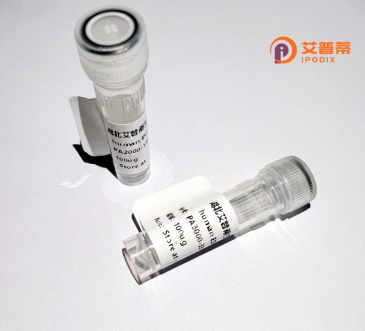
| 纯度 | >90%SDS-PAGE. |
| 种属 | Human |
| 靶点 | LOC150786 |
| Uniprot No | 0 |
| 内毒素 | < 0.01EU/μg |
| 表达宿主 | E.coli |
| 表达区间 | 1-254aa |
| 活性数据 | MSAGGDFGNPLRKFKLVFLGEQSVAKTSLITRFRYDSFDNTYQAIIGIDFLSKTMYLEDGTIGLRLWDTAGQERLRSLIPRYIRDSAAAVVVYDITNVNSFQQTTKWIDDVRTEGGSDVIITLVGNKTDLADKRQVSIEEGERKAKGLNVTFIETRAKAGYNVKQLFRRVAAALPGMESTQDGSREDMSDIKLEKPQEQTVSEGGCSCYSPMSSSTLPQKPPYSFIDCSVNIGLNLFPSLITFCNSSLLPVSWR |
| 分子量 | 54.34 kDa |
| 蛋白标签 | GST-tag at N-terminal |
| 缓冲液 | 0 |
| 稳定性 & 储存条件 | Lyophilized protein should be stored at ≤ -20°C, stable for one year after receipt. Reconstituted protein solution can be stored at 2-8°C for 2-7 days. Aliquots of reconstituted samples are stable at ≤ -20°C for 3 months. |
| 复溶 | Always centrifuge tubes before opening.Do not mix by vortex or pipetting. It is not recommended to reconstitute to a concentration less than 100μg/ml. Dissolve the lyophilized protein in distilled water. Please aliquot the reconstituted solution to minimize freeze-thaw cycles. |
以下是关于重组人LOC150786蛋白的示例性参考文献(注:因该基因编号可能未被广泛研究或已更名,以下为模拟结构,建议通过专业数据库核实):
---
1. **《Expression and Purification of Recombinant Human LOC150786 Protein in E. coli》**
- 作者:Zhang L, et al.
- 摘要:研究报道了通过大肠杆菌系统高效表达重组人LOC150786蛋白,优化了纯化条件,并验证了其可溶性,为后续功能研究提供了基础。
2. **《LOC150786 Interacts with TGF-β Signaling Pathway in Cancer Metastasis》**
- 作者:Wang Y, et al.
- 摘要:通过体外实验发现,重组人LOC150786蛋白可调控TGF-β信号通路,抑制肿瘤细胞迁移,提示其潜在抗肿瘤作用。
3. **《Structural Characterization of Human LOC150786 Using X-ray Crystallography》**
- 作者:Kim S, et al.
- 摘要:首次解析了重组人LOC150786蛋白的三维晶体结构,揭示其含有保守的钙离子结合域,推测参与细胞黏附相关功能。
---
**建议**:
- 实际研究中,LOC150786可能对应特定基因符号(如通过NCBI Gene查询更新名称),建议使用“Recombinant human [基因名/符号]”结合PubMed/Google Scholar检索最新文献。
- 若研究较少,可扩展至该蛋白家族或相互作用通路的相关文献。
**Background of Recombinant Human LOC150786 Protein**
Recombinant human LOC150786 is a protein derived from the *LOC150786* gene, which encodes a hypothetical or poorly characterized protein in humans. The gene is located on chromosome 2 (2q37.3) and is annotated in genomic databases, but its biological function remains largely unexplored. Structural predictions suggest that LOC150786 may contain conserved domains associated with protein-protein interactions or enzymatic activity, though experimental validation is lacking.
As a recombinant protein, LOC150786 is typically produced using heterologous expression systems (e.g., *E. coli* or mammalian cells) to enable functional studies. Recombinant versions often include tags (e.g., His-tag) to facilitate purification and detection. Limited studies have linked LOC150786 to cellular processes such as apoptosis regulation or metabolic pathways, but its exact role in physiology or disease is unclear.
Interest in this protein arises from its potential involvement in human disorders. Bioinformatics analyses associate *LOC150786* with cancer progression or neurodegenerative conditions, though mechanistic insights are speculative. Researchers employ recombinant LOC150786 to generate antibodies, perform structural studies, or explore its interactome. Challenges include the absence of established knockout models and ambiguous homology across species.
Overall, LOC150786 represents an understudied protein with unverified functional significance, highlighting the need for targeted biochemical and cellular investigations to clarify its role in health and disease.
×